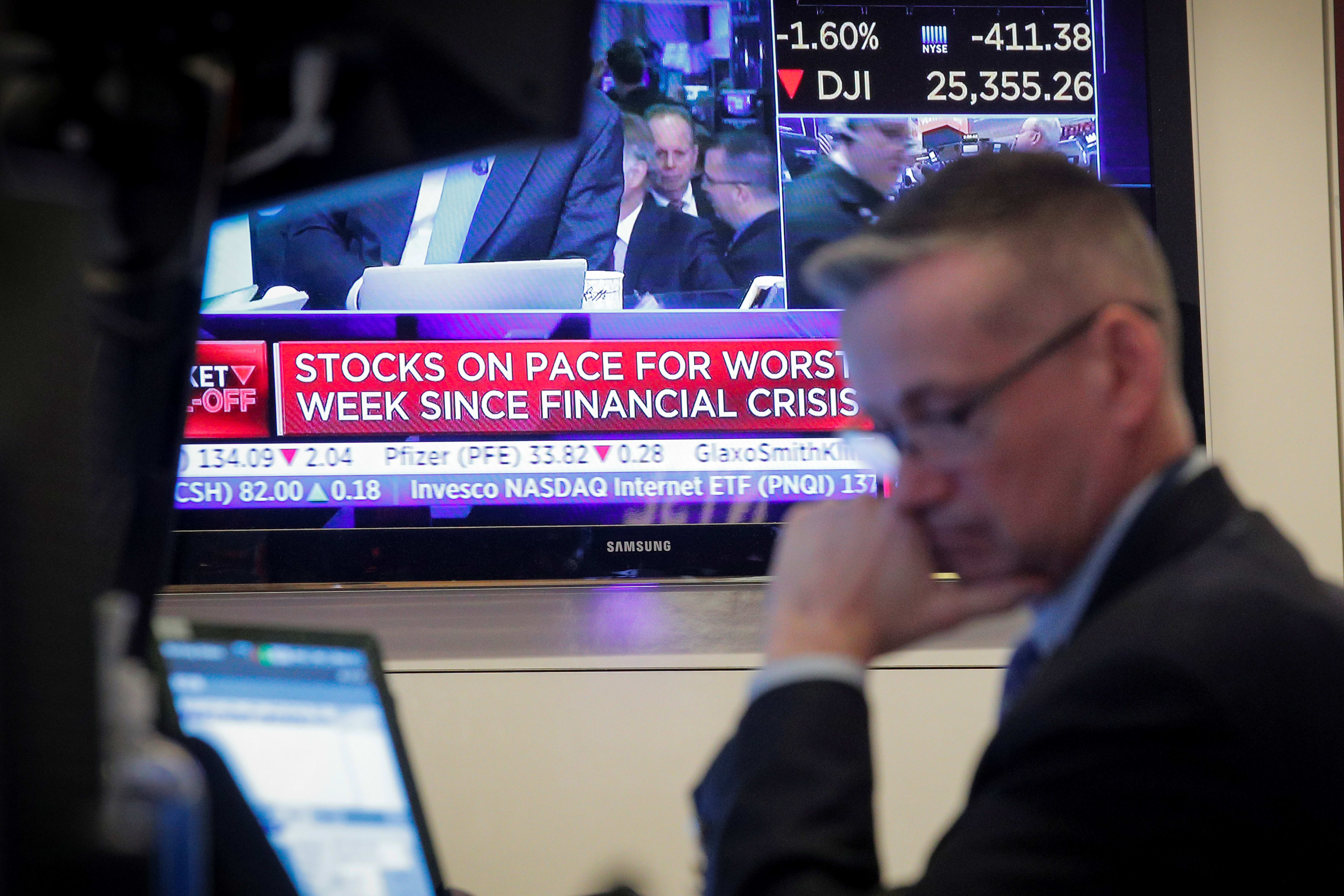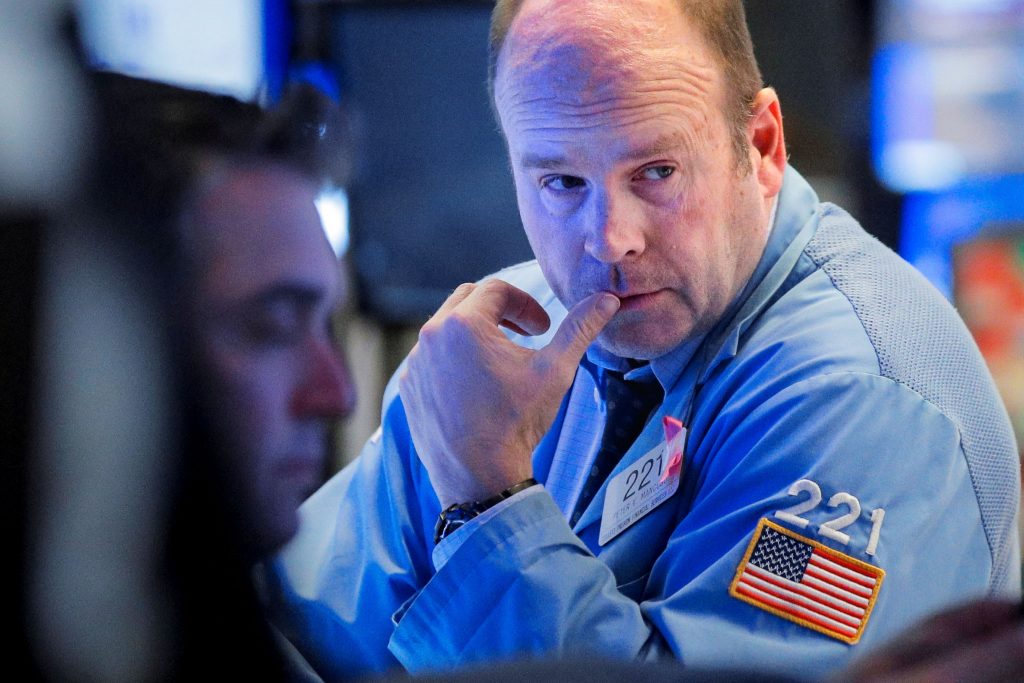
Traders work on the floor at the New York Stock Exchange (NYSE) in New York, U.S., February 28, 2020.
Brendan McDermid | Reuters
The stock market has rushed with historic speed to an extreme place. This means, among plenty else, that the tape is becoming stressed and stretched in a way that tends to precede the kind of reflex rally that is sudden, powerful and probably untrustworthy.
The damage toll from the 12% collapse in seven trading days is a litany of rarities.
On the highest weekly volume in nearly a decade, the selling became indiscriminate and generated oversold readings for the record books.
- Fewer than 20 stocks in the S&P 500 are still above their 50-day average price.
- The broad Dow Jones Composite index went from a 52-week high to 52-week low in ten trading days, fastest on record dating to the 1930s, says technical strategist Jonathan Krinsky of Bay Crest Partners.
- The McClellan Oscillator gauge of declining versus advancing volume had two of its 20 most negative daily tallies of the past two decades last week. The majority of these extremes were seen near in time to some kind of significant trading low (in 2018, early 2016 and 2011, say) — except the ones that flashed in the midst of a long-running bear market (2001 and 2008-2009).
This means the coronavirus-spread panic opened a trap door under the market and almost everything fell through.
We’re now in the investing equivalent of assessing various hurricane models. The storm has devastated the outlying and coastal areas – the final 12% upside of a bull market that has delivered a 12.5% annualized return for the past decade.
The more populated regions are now threatened. Most of the meteorological models say storms like this don’t last much longer at full strength before spinning out to sea. The forward returns from similarly equity washouts have been better than average market performance over ensuing months and out to a year.
But the exceptions to this comforting pattern are scary, and to many, the smart move seems to be to prepare for the worst.
“There has been enough near-term downside exhaustion to suggest a reflex rally should occur,” says Krinsky. “How far and how long that lasts, however, is going to need to be monitored on a day to day basis.”
As usually happens in a market shock, there are proximate causes and collateral factors.
Obviously, the global spread of coronavirus infections and the dramatic measures being taken to contain it have halted the Chinese economy, upended prevailing expectations for an imminent global-growth acceleration and fogged the corporate-earnings outlook, while compressing bond yields to unseen levels and stoking urgent calls for aggressive central-bank responses.
But all this struck a market that was also richly valued and over-loved, with a huge implicit bet on continued calm and enduring leadership by the marquee growth stocks of our time.
So, aside from pricing in the growth impact of the virus outbreaks, we’re seeing a headlong unwinding of strategies premised on market calm and momentum — a wave of forced selling that has largely if not entirely washed through the market by now.
Still, the CBOE S&P 500 Volatility index remained above 40 Friday, even as it slipped from a high close to 49. On one hand, a surge and retreat by several points is one clue to a fear crescendo and possible rebound attempt.
On the other, a VIX above 40 (up from 13 earlier last month) also shows intense hedging by trapped market participants and suggests investors shouldn’t be too stridently confident in trying to map the path from here.
A few observations about where this has taken the market:
- At Friday’s lows, with the S&P 500 near 2850, the market effectively returned to last summer’s lows — a time of flaring recession fears and deep doubts about an industrial recovery. So equities reversed the entire “cyclical inflection point” trade that lifted stocks from October through most of February. That goes some distance toward resetting expectations and turning complacent optimism to agitated anxiety.
- The S&P 500 also fell below its high from January 2018, this cycle’s prior peak in optimism, momentum and valuation. Does it make sense for longer-term investors to buy the S&P at prices from 25 months ago after the value of Corporate America was just cut by one-eighth in a week’s time?
- As noted, the market started this reset from stretched valuations and positioning, and unwinding that is a slippery process, prone to overshoots. This is just one reason the traders’ playbook typically says the first major rally off a correction low faces a high burden of proof and frequently requires a period of choppy, spring-loaded action and retests.
- This sort of quick double-digit drop from a record high immediately recalls the January-February 2018 correction. The peak in selling intensity came early, with a Friday cascade somewhat reminiscent of this past Friday. But then came a sawtooth phase of screaming rallies that failed and renewed declines, with a retest of the early-Feb low nearly two months later that held and within months led to a fresh record high.
- In such stressed markets, traders playing for a mean-reversion pop of a few percent face off against investors quick to sell to stay out of the way of a 12% correction that might sink to a 20% wipeout. One such wipeout culminated in December 2018 – two months after an initial 10% correction flashed encouraging oversold readings like the ones we see now.
- Chances are, the market isn’t specifically waiting for news that everyone interprets as proof the virus spread is controlled and the ultimate damage to the economy quantifiable and modest. The market will hurry to try to price in a series of dire scenarios until the probable outcomes represent a welcome relief. Wall Street’s ability to absorb the inevitable barrage of headlines of new cases and corporate challenges has not been tested yet.
- Here the 9/11 terrorist attack shock might be instructive. Stocks were already laboring in a year-old bear market when the attacks occurred. Stocks cracked as soon as markets reopened several days later, amid common predictions that American life would never return to normal, uncertainty if people would travel again and a belief that stocks deserved lower valuations to account for the more treacherous world. The tape was twitchy after that to any headlines about bomb scares or threatened attacks — until it wasn’t. Stocks within a week began a 20% rally as the Fed eased, the economy restarted and oversold stocks got relief (until the bear market resumed amid a recession in 2002).
- Credit markets have weakened, but only modestly compared to the equity carnage. This, for now, suggests bond investors are not rushing to price in sharp and lasting economic pain that would undercut corporate solvency and augur a recession.
- One result is that the S&P 500 dividend yield is now higher relative to corporate-bond yields than it’s been in decades, as shown by this chart from FundStrat.
That might not seem like enough of a cushion to rely on against the frightening headlines and wide uncertainty band facing investors.
We very well could be early in the economic-reckoning process — or this could be a weeks-long panic that fades quickly as a driver of the markets.
The best advances of this 11-year uptrend have come when the saturating fear of some daunting threat (sovereign-debt defaults, oil crash, China financial crisis, trade war) proved unfounded or overdone. It’s worth remembering this — without treating it as a sure thing in the current market test.
Subscribe to CNBC PRO for exclusive insights and analysis, and live business day programming from around the world.

